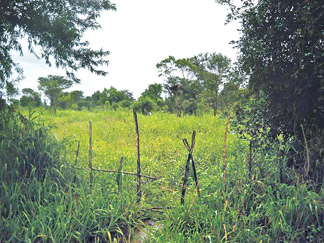|
Heritage of Sri Lanka:
Withering traditions of Chena cultivation
Prof W I Siriweera
As in the rest of the world in Sri Lanka too, the earliest form of
agriculture was chena or slash and burn cultivation. It was a system in
which the main characteristics were rotation of cultivating plots rather
than of crops, clearance by means of fire and short periods of soil
occupancy alternating with long fallow periods in order to ensure the
periodic exploitation of soil fertility.
The chena farmer chose a patch of forest, secondary or primary, cut
down some of the trees, leaving only the larger economically useful
ones, cleared the undergrowth with a knife or cutlass and burnt the
debris. Generally the only fertilizer the crops received was the ash
from the initial burning which provided potash. Burning also heated the
surface soil and sterilized it against the organisms responsible for
diseases.
The chena cultivation was dependent on rain water and did not require
a regular supply of water. Thus the initial adoption of rice (Oryza
sativa) in the beginning of the first millennium B.C. did not require
any great advance in technology either and dry paddy could be grown in
rotating plots. Medieval Sinhala literature refer to rice grown under
slash and burn techniques as alvi or goda goyam.
|

A Chena cultivation |
Only when the demographic growth necessitated an improvement in the
methods of cultivation, irrigated rice techniques became important. The
overall balance however, between chena and irrigated rice agriculture
varied, depending on the rainfall and the availability of land, water
and man-power.
Apart from paddy, three crops grown in chena plots namely cotton (Gossypium
harbacenumi), sugar cane (Saccharum officinarum) and sesame (Sesamum
indicum) were important throughout the historical period and three
principal cottage industries developed around them. In classical
literature, there are frequent references to kapu hen, uk hen and tala
hen which mean chena land where cotton, sugar cane and sesame were
grown. As only luxury cloth was imported to the island particularly from
Eastern India and China even during the heyday of the Rajarata
civilization for the use of the royalty and nobility; the island’s
requirements of cloth had to be met from within.
Thus cotton (kapu) had to be grown extensively to cater to the
weaving industry. Sugar requirements of the people were met by the
cultivation of sugar cane (uk). References to machines used for the
extraction of juice from sugar cane (uk yanthra) and jaggery made of the
juice (uk sakuru) are frequently found in classical literature. As in
Mesopotamia, edible oil was obtained mostly from sesame in the ancient
Dry Zone and that explains the frequent references to tala hen in the
texts.
Kurakkan or finger millet (Elusine coracana) was a key substitute for
rice in the Dry Zone throughout the historical period. Hence, chena
cultivators grew finger millet as a main cereal crop along with other
cereals such as undu (Phaseolus mungo), ma (Vigna cylindraica), mun (Phaseolus
aureus), meneri (Paspalam scrobiculatum), aba (Brassica juncea) duru (Cuminum
cuminum) and tana (Setaria italica). In these chena cultivations
intertillage or mixed cropping was common. The main vegetables grown in
them were karabatu (Solenum sp.), tibbatu (Solenum indicum), vambatu (Solenum
melongena) alu puhul (Benincasa hispida) and vattakka (Cucurbita
maxima).
Even after the abandonment of the Dry Zone civilization in the middle
of the thirteenth century, chena cultivation continued throughout
centuries and it was the main sustenance of the peasants in isolated
pockets of settlement. Leonard Wolf’s Village in the Jungle clearly
depicts the nature of the subsistence system in the Dry Zone from the
thirteenth century onwards until the colonization programmes began in
the 1930s.
In the historical era until about the beginning of the twentieth
century, chena land belonged to collective village communities. It was
through amicable arrangement by villagers that in each season what
portion to be allotted to a person was decided. The selection of
locations for chena was done through group consensus and it was confined
to the area of authority of the village.
The farming schedule was prepared after discussion with all
prospective chena cultivators in the area so that group action could be
ensured throughout the period of cultivation. The overall protection of
the plots was also ensured through group action as guarding the crop
against wild animals was done in turns.
Forest laws
Later, the British government claimed all unoccupied forest land and
introduced forest laws. The Forest Ordinances prohibited the clearing of
Crown land for chena cultivation without permit.
Chena permits were not given for cultivation of land within 100 yards
of a high road; 50 feet of a stream or any area of forest containing
full grown trees. The clearing of land liable to erosion or required as
protective catchments was also prohibited by a land order in 1940 which
precluded from cultivation, land with a slope of over 30 degrees and the
tops or whole of forest clad hills. However, such rules and regulations
were not enforced due to the shortage of food and Emergency Food
Production drive during Second World War.
After independence, the government allowed the use of forest land for
purposes of chena cultivation by continuing the system of issuing
permits. But the issue of permits was officially terminated in 1981. Yet
chena cultivation takes place particularly in the Dry Zone and to a
lesser extent in the intermediate zone even at present.
To be continued |



